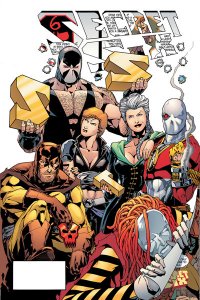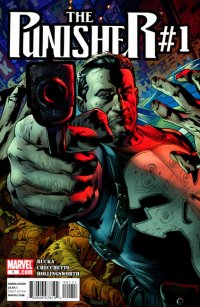DC Retroactive 1980’s Flash one-shot (DC Comics, $4.99)
by Graig Kent
My comic book collection up until 1987 basically consisted of random issues of comics from DC, Marvel, and a few now defunct publishers, almost all obtained from 3-for-a-dollar grab bags that you would find at department stores. The closest thing I had to a series run was a dozen or so issues of Who’s Who In The DC Universe. But come 1987, a short time after DC’s big post-Crisis reboot of their comics line, I quickly became a regular visitor to my local spinner rack, sucked in by the new Justice League, the refreshed take on Superman, and a brand-new Flash, the first character I was ever aware of to graduate from side-kick to full-fledged hero.
Over the following 10 years writers Mike Baron, William Messner-Loebs and Mark Waid shone a decidedly different light on Wally West in attempt to free him from the shadow of Barry Allen, first by making him one of very few superheroes to go public with his secret identity, then by dealing with his family and financial issues, and also his womanizing. Barry Allen’s old foes, his rogues gallery, really didn’t want to mess with Wally, not because he was superior to his uncle, but because, like many readers, they didn’t see Wally as the real deal, and a few of them even reformed for a while. Later Waid would build up the mythology of the Speed Force and provide Wally with a steady romantic relationship and a sidekick of his own in Impulse, but during Messner-Loeb’s run, he really approached the most human side of superheroics and all the mundane things that have to happen when you’re not punching bad guys in the face.
The back-up feature in this week’s Retroactive 1980’s Flash one-shot comes from Flash #18, the third part of a three part story. While it’s a curious choice to include an incomplete story as a back-up feature, it actually exemplifies Messner-Loeb’s run quite well, with Wally’s mom stressing out over their dismal financial situation, and Wally, having just outrun a bomb blast, needs to make a pit stop to eat, but these diversions are integrated well with an exciting adventure story. Plus we’re reminded of Chester Runk, Wally’s friend who has a living black hole in his belly which allows him to make objects disappear at will. I kind of forgot about him and was reminded of what a unique character he was, not a superhero, just a guy with a weird ability trying to get by.
The main feature, which reunites Messner-Loebs with his long-time Flash artist Greg Larocque is quite slight in comparison. It’s a straight done-in-one story that has no side tracks (something Messner-Loebs does quite well, so it’s a shame) wherein a Flash obsessed woman uses her feminine wiles to abscond with Rogues technology one-by-one in an effort to get the Flash, her “boyfriend”, Wally West, to notice her. Messner-Loebs recalls accurately the tone of Wally’s relationship with the Rogues, which is one of tolerance, with a hint of animosity, as well as his sensitivity towards his foes. It’s a light but enjoyable tale (though Messner-Loebs tries to be too clever at one point with a cell phone gag that falls a little flat), with some solid art from Larocque that recaptures the feel of his past work but is quite a bit more polished when compared with the back-up. It’s not necessarily brilliant, but it’s a pretty good reminder of what I enjoyed so much about Wally West as the Flash, and how bummed I still am that Barry Allen came back.
Rating: 




Out of a Possible 5 Stars
Secret Si x #36 (DC Comics, $2.99)
x #36 (DC Comics, $2.99)
by Graig Kent
And there you have it. For three years Gail Simone’s Secret Six has been one of, if not the most provocative book in the mainstream, following a ruthless gang of villains-for-hire as they fought their way through another dimension, hell itself and each other (and that’s just the past year), all the while forming easily the most dysfunctional “family” atmosphere witnessed this side of The Devil’s Rejects. The cast fluctuated somewhat, at times the roster was under and other times over the titular Six members, but there was a core group that came to, well, not depend… nor respect… nor even altogether like each other… the fact of the matter is the six stayed together because it seems that they were the only ones who would tolerate each other, and even then you were never sure if Bane was going to crush Catman’s skull or Deadshot would shoot King Shark in the face at the slightest provocation. Many of the adversaries Simone created or adapted for the series were extremely twisted, but none more than the series regulars, especially Ragdoll, a mangled eunuch with a more frighteningly warped sense of humour than the Joker and Freddie Kruger combined. But as wild, sick, and disturbing as the characters could get, Simone tempered them with redemptive qualities, albeit the slightest of redemptive qualities, just enough to warm the readers to the characters. Hell, she made Catman kind of cool, and she actually made Bane an interesting, viable A-list villain, 15 years after he was created to be the ultimate Bat-villain. But with the big September New-52 initiative, the Six is no more, and Simone sends them out Butch and Sundance style against a gaggle of superheroes. Alas, it’s a rushed affair, and it finds the characters reduced to almost cliches, as she says goodbye to them prematurely. Closing the book on her cast was obviously not a satisfying process for Simone and it translates into an unsatisfying goodbye for the reader. A book that maintained such a consistently high quality for three years deserved better than this (a refrain I’m sure will be repeated throughout the month as other titles close down).
Rating: 




Out of a Possible 5 Stars
The Punisher #1 (Marvel, $3.99)
By Jeb D.
Among the reactions to last week’s reveal of the new Ultimate Spider-Man, a common thread was the complaint that ethnic characters shouldn’t have to settle for being knockoffs or alternate versions of established white characters: that DC and Marvel should be creating new characters that break barriers of color, gender, etc. A reasonable argument as far as it goes, but one that overlooks the simple fact that the Big 2 have only sporadic success at selling any new characters to the reading audience at all: the “youngest” of the major franchise characters at either company is Wolverine, who first turned up during the Nixon administration; some new team franchises flourished in the 80’s and 90’s, but always fleshed out with established characters: the idea that it’s somehow easy to create a new book with a new or secondary character and have them sustain an audience wildly oversimplifies the state of the market.
And yet, despite all that, Frank Castle soldiers on. The backmatter in the first issue of his latest series sketches his publication history, and the impressive list of series (I believe this one is technically his eighth ongoing) and mini’s that they cite barely touches on the number of creative teams that have taken a shot at him (so to speak); he’s managed to hang on for all these years when well-intentioned new character experiments continue to fall by the wayside.
I suppose simplicity might have something to do with it: while most comic characters (most superheroes, anyway), begin with a simple, straightforward motivation (grief at the death of parents and/or uncles is a popular one), they quickly find themselves enmeshed in the complex workings of their universe; they find super-peers or teammates; their secret identity acquires a career, friends, colleagues, lovers… For the most part, The Punisher has managed without that. He doesn’t integrate well, and he seems to attract outstanding writers for the opportunity he provides them to present their view of a violent world in a sort of pure, unadulterated form: The Punisher started as a villain, with a comic-book villain’s clarity of purpose, and unlike the typical Marvel baddie-turned-goodie (Hawkeye, Medusa, etc.), he’s never looked back, even if our perspective on him has shifted to something closer to “anti-hero.”
Given the desire to launch a new Punisher book, you’d hardly do better than veteran writer Greg Rucka, whose finest work (Queen and Country, Gotham Central) has dealt with the darkness in the souls of decidedly un-super folks. His take here, in this first issue, is to let Frank’s legend underscore the murderous workings of some rival gangs, and the detectives faced with their grisly handiwork, while the man himself is an almost unseen presence, but one that casts a shadow across many of the other characters. The principal protagonists are a well-characterized pair of detectives, veteran and young hotshot, one of whom is hiding a guilty secret involving The Punisher, the particulars of which are revealed to us in a brilliantly told backup story that I won’t spoil. Apart from that, the setup is familiar: Frank’s in the middle of a gang war, the cops are in over their heads, and no one’s getting out clean. I like the idea of Frank appearing to us mostly in the fearful, resentful, and disbelieving perspectives of the lives he’s touching; and when he finally does show up, Rucka actually manages to have him surprise us with a gesture I don’t know that I’ve ever seen from Frank before. As usual, Rucka’s feel for the procedural, and the way these men talk, think, and work, makes the story pulse with life.
Italian artist Marco Checcetto and colorist Matt Hollingsworth bring the kind of cinematic look we’ve come to associate with recent Punisher artists like Laurence Campbell and Jefte Palo, and his paneling is imaginative, from the whoosh of the speeding subway trains to the impossibly bloody carnage that sets off the story.
And that’ s actually got me wondering… there is nothing in this first issue that would be out of place in the MAX version of The Punisher: it’s every bit as bloody as anything Ennis ever wrote (“Parental Advisory” seems like an understatement), and makes me fear that maybe Marvel’s going to close up shop on the MAX book, since they’ve clearly allowed Rucka and the artists to take the gloves off in a big way here. That would certainly be a shame, as Jason Aaron and Steve Dillon are turning out a uniquely warped comic series; the irony here is that Rucka and Checcetto might actually be out-MAXing them.
Rating: 




Out of a Possible 5 Stars